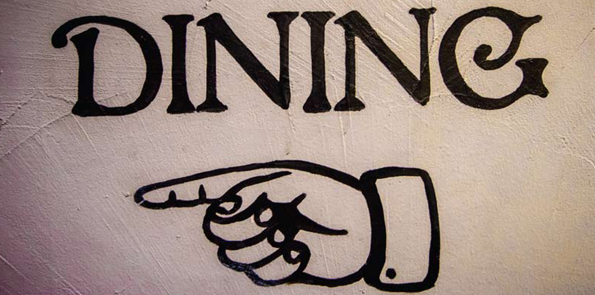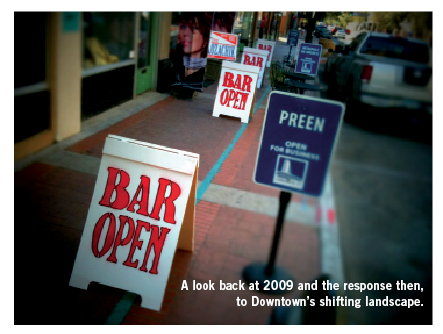Downtown’s Shifting Landscape
All progress is precarious, and the solution of one problem brings us face to face with another problem.
– Dr. Martin Luther King, Jr.

Directional sign at Maynards Market. photo: David Olsen
In the mid-‘80s and through the ‘90s and early ‘00s, Downtown was considered a schlumpy locale eschewed by seemingly many Tucsonans. It was the artists, musicians, the writers and photographers, galleries, bars, a handful of entrepreneurs, restaurants, long-established families, some smart investors and renters who comfortably called it home. The cheap rent and authentic vibe drew those to the area.
As progress happens, so does construction, such as the 4th Avenue underpass and the streetcar tracks. Congress Street, as was the revitalization goal, is a different place than it was five years ago. Only a handful of pre-2009 businesses along that strip remain.
Today, Congress Street is certainly a destination for food and drink. It’s not a destination for the arts, the galleries mostly ring the northern edge of Downtown in the Warehouse District. Three galleries that were in the Downtown core are leaving or have left: Sacred Machine, 245 E. Congress St., Atlas Fine Art Services, 41 S. 6th Ave., and Obsidian Gallery, 410 N. Toole Ave.
For Sacred Machine’s proprietors, Paula Catherine Valencia and Daniel Martin Diaz, closing shop isn’t related to the Downtown economy or foot traffic. Theirs is a career move to L.A. However, Paula’s observation was this: “If you want to know what challenge might be happening with galleries down here is that it’s not necessarily a walking destination like 4th Avenue. You know, people go there, they walk, they’re used to looking through shops and hanging out. Their main thing isn’t to eat and drink there. When all that you have Downtown is restaurants and bars, people are here for lunch and dinner and to party later at night. Their agenda is to eat and drink, their agenda is not to shop and browse. So that becomes a different thing all together. I think that’s what’s happened with Congress Street.”
With Atlas Fine Art Services, which opened in August 2011 when Downtown was gaining traction with new restaurants—which would presumably help with foot traffic—it was difficult to gain traction themselves and they closed earlier this year.
Co-owner James Schaub wrote via email, “Foot traffic was something we hoped for and would have been helpful—but it never came. The foot traffic that happens Downtown is still much the way it used to be—people park as close as possible (increasingly harder to do) to where they want to go and go to that place and then drive to the next place. Our business, and others like it, is more of a destination. We usually knew when people were coming in—they called in advance. The students who now live Downtown are similar, most have cars and there is no real retail culture yet in the Downtown.”
Valencia also commented on the public’s parking habits: “I think another thing too is, we even have parking garages and people don’t want to park, so not only do they not want to park, they don’t want to walk. Something needs to change probably, and, possibly the streetcar will be the key. We’re not sure, but it could possibly be a help, to get people and things moving a little bit more.”
Diaz added that, “I think the most successful cities is where there’s circulation. For instance, Prescott; it’s a little town and they have the square, and you go in this circle and you can go in that circle all day and really not get bored because it’s so beautiful, but there’s no circle here in Tucson where you can walk and just go around and look at shops and come back around. You walk in a straight line. And who knows where you end up.
“I think that’s a really important thing,” Diaz continued. “I think that we have the potential to do it, with Congress and 6th and then come back around, but everything is on the outside. You need squares, and a park in the center.”
Having a focal point, a zócalo if you will, would be a wonderful thing for Downtown, and the Ronstadt Transit Center would be the perfect place. Maybe one day. There is currently a Request for Proposals out for a joint development of the Ronstadt Transit Center. (See www4.tucsonaz.gov/integrated-planning/joint-development-ronstadt-transit-center-project-area.)
At the end of April, Downtown Tucson Partnership CEO Michael Keith and I did a walking tour of the core, starting at the east end. I parked at Plaza Centro garage and met Keith outside of Gio Taco, 350 E. Congress St.
Signs in the first floor of The Cadence, the student housing complex at 350 E. Congress St., promise the upcoming arrival of Planet Smoothie and Fed By Threads, a sustainable clothing store. (Fed By Threads co-owner Alok Appadurai says mid-May.)

“Bar Open” signs placed along Congress Street, fall 2009.
photo: David Olsen
As we walk by the Rialto Theatre, Good Oak Bar, Diablo Burger, Proper, then Playground, and before peeking into the still under construction Pizzeria Bianco, I have a flashback to 2009.
David Aguirre, Director of Dinnerware ArtSpace—a gallery that had been displaced, along with a couple others, from Congress Street in 2009 when there were initial plans to have Kwang C. An open a restaurant in the 200 block of East Congress Street—had placed several A frames along the sidewalk with the words “Bar Open” on both sides of the signs. It was funny in a prophetic, times are a’changin’ sort of way.
It’s not all bars though, there’s food—HUB and Saint House, though both are known for their cocktails. Across the street there’s Yoga Oasis, Sacred Machine, FORS, Connect Beta, Xoom Juice and Sparkroot. On the next block there’s the Olive Orchard Gourmet Pantry coming to 222 E. Congress St., Buffalo Exchange is there, Studio 220/Got All Your Marbles, Tierra Antigua Realty, Iguana Cafe and Crescent Smoke Shop.
Around the corner and south on 6th Avenue is the forthcoming Johnny Gibson’s Downtown Market in the old Beowulf Alley Theatre space at 11 S. 6th Ave., then there’s The Drawing Studio, Flash in the Past Vintage Pinup Photography Studio, La Fashionista (sharing it’s space with Wig-O-Rama), and Black Rose Tattooers.
Swinging back down to Congress Street, we pass Chicago Music Store and pop into the forthcoming Saint Cecilia Studios—which looks beautifully awesome (see story in last month’s issue). We pass MEB Management and Unplugged Wine Bar; Voodoo Jack’s and Wig-O-Rama sit empty, awaiting restoration due to damage caused by a fire that gutted Grill over a year ago. We look across the street and see, from 6th Avenue to Scott Avenue: Hydra, Empire Pizza, Elliott’s on Congress, The Screening Room, Zen Rock; then, from Scott Avenue to Stone Avenue, JunXion Bar, Jimmy John’s, On a Roll, Sapphire and the upcoming H2O club. Further west, there’s A Perfect Pantry, Lesco Optical, V Thai; from Stone to Church Avenue, the Fox Theatre, Subway, Caffe Milano, Rice House.
Scott Stitler, owner/landlord of the buildings on both sides of the 200 East Congress Street block, said, “Today, I’m not interested in more food,” when talking about what kind of tenants he is looking for to occupy the spaces at 245 E. Congress St. that will become empty once Sacred Machine, and possibly Connect Beta, move out.
Stitler, who also co-owns the Rialto Block with Don Martin, explained that he doesn’t just take any tenant interested in one of his available spaces, he is thorough and selective. “I don’t advertise or put ‘For Rent’ signs in the windows, I’m hyper focused on all three blocks for a good mix, I’m constantly processing all these cities I visit, I travel a lot and take a lot of pictures.
“It’s takes a lot of patience, Pizzaria Bianco is a perfect example. We had 40 or 50 unsolicited offers, and it is tough to manage because you are dealing with nice people, but I was glad I said no on that space, because once Chris (Bianco) came along, and he’s had hundreds of offers to do another Pizzeria Bianco, and after 23 years of saying no, he searched his soul and his soul said yes to Tucson, and this space.”
Stitler said he has had offers on the spaces already, some of them are food, but he’d rather allow the current restaurants to stabilize and he doesn’t want “to add another two or three more.”
“It’s hard on everyone to make it in a month. The short answer is to let some of these projects get further along. Restaurants always lead an area that is getting revitalized, and then you get an office and then an apartment building and so on and so forth. I like where we are from five years ago, and we still have a ways to go, with more housing and more jobs Downtown.”
He paused, and said what is on a lot of people’s minds, “I hope the streetcar is a successful launch.”
Category: Arts, Business, Community, DOWNTOWN / UNIVERSITY / 4TH AVE, Living, MUSIC




